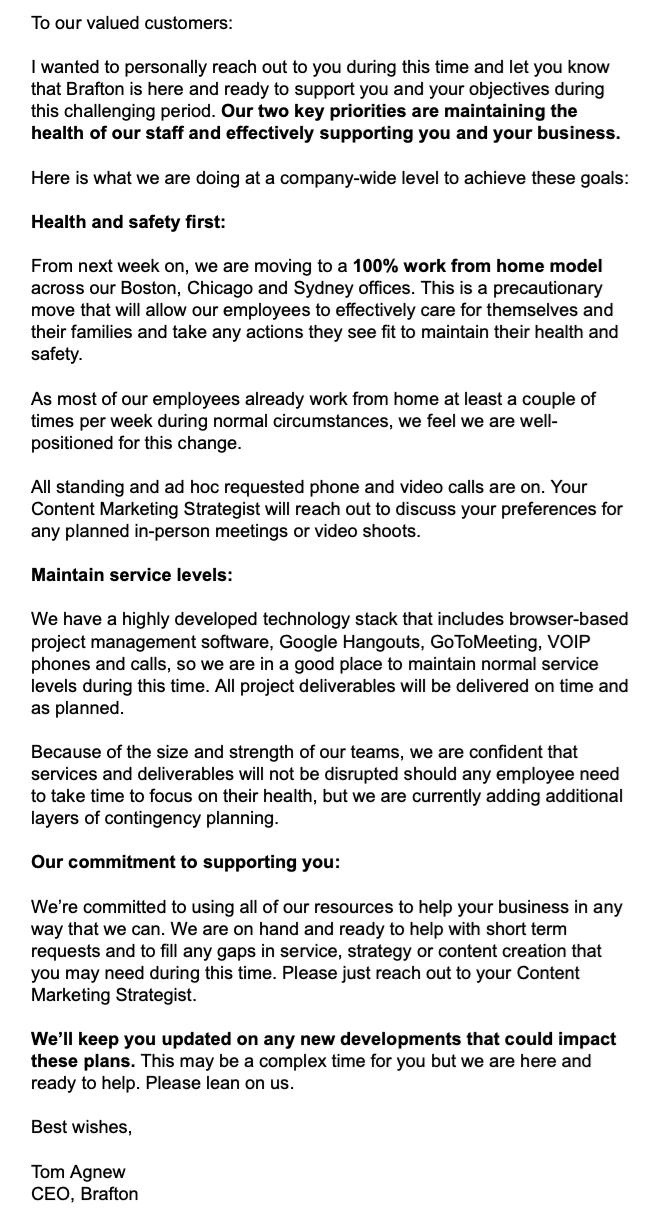You know the saying about picturing people in their underwear to feel less nervous during a big meeting? All of America is in its figurative underwear right now (some of us are in our literal underwear, too).
If you’ve never fully taken a moment to think of your clients and customers – even the annoying ones – as real, vulnerable people who cry at the end of “E.T.” and stub their pinky toe and sometimes get sick, now’s the time to start.
Every single client communication for the next few weeks – maybe months – is with a person enduring a pandemic first, and a customer, second.
With that in mind, here’s a list of communication protocols for COVID-19 (we, like everyone else, are admittedly learning as we go):
Make a position statement
It’s important to formally acknowledge the situation (if you haven’t already done so). And no, this is not business as usual, even if it is. In fact, using that phrase at all will make you sound dismissive, regardless of how minimal the disruption to your business.
Draft a position statement to go out to all clients informing them that you’re:
- Adjusting your workflows to align with public health best practices. This might mean switching to a complete work-from-home model and postponing or canceling all in-person meetings indefinitely.
- Doing everything you can to maintain service levels, and that your day-to-day contacts will be in touch well in advance of any potential disruptions. This will be more challenging for some companies than for others.
- Ready to make service adjustments to provide support during this crisis. Just keep in mind that you’re not making a promise here. You’re just acknowledging that you want to continue to be a partner with your customer, even if in a slightly different capacity than you were before.
- Keeping communication open with all stakeholders. It doesn’t matter if it’s via email or directly on your client portals, the goal is to keep communication open.
In case it’s of any help, here’s the email our CEO sent out to our clients:

Be flexible, collaborative and understanding
Don’t expect to be priority No. 1 right now.
If you get stood up at a call or your emails are going into the void, assume that your client is putting out a coronavirus-related fire. Or trying to chase down a COVID-19 test for an older parent. Or helping one of several children do algebra. Or all of the above.
Chances are, they will be equally mindful of the fact that you’re also in crisis mode at the moment. Still, do everything you can on your end to respond to requests in a timely manner.
Practice crisis-communication etiquette
In person
Don’t do it.
Unless you’re an essential service with no other option.
Via email
Start every message hoping you find them (and their family) in good health.
It’s a small thing, but it shows that you’re thinking of them as a person first.
Maintain a collaborative and understanding tone.
Avoid making assumptions about what your clients can or cannot do. Be highly collaborative, and try to ride out any operational inconveniences.
Use phrases like “during this time” and “value our partnership.”
Anything to remind your customer that a) this is temporary and b) you are partners, and you will do whatever it takes to come out of this in step.
Over the phone or via video conference
Be human.
We all need to feel like we’re in this together right now, and that means being vulnerable with your clients. It won’t change our reality, but it makes it a little more tolerable.
Ask clients how they’re doing.
For instance, how has working from home been for them, and how has it changed their work?
Ask how COVID-19 is affecting their business.
Make sure you’re taking a pulse of how your clients and their customers are being affected. It may help you avoid unforecasted pauses or cancellations in service. This may mean spending more time checking in with otherwise low-touch accounts. But it may mean fewer surprises when renewal time rolls around.
When seeking payment
Be open, transparent and collaborative.
Don’t be afraid to ask clients for money owed but always do so in a courteous way. Be engaged and receptive when customers flag payment problems, and be sensitive to the fact that they may be struggling. Work with them on creating a temporary repayment arrangement within their means. If it makes sense for your business, you might even consider providing an incentive for upfront payments.
Never use guilt as a means of upselling or trying to collect payments.
With few exceptions, everyone’s hurting right now. The last thing clients need during this crisis is a guilt trip from you about how tough a time you’re having.
When inquiring about service renewals
Use what you already know to your advantage.
Remember how we said you should be checking in regularly with clients? This is why. Try to anticipate barriers to renewals, and frame your pitch around business’ shifting requirements during the crisis. That might mean acknowledging that it makes sense to reallocate spend to focus on certain areas.
When saying ‘no’
Obviously, avoid it at all costs.
Anything you can do at this time to go above and beyond will be remembered when it comes time to renew contracts, or if there’s an opportunity for more business when this is all over.
But be realistic.
A lot of companies are tightening their belts right now, and there is an element of self-preservation to keep in mind. Do not overpromise, and be mindful of you and your company’s limitations right now.
And this too shall pass
In one of my favorite books, there’s an anecdote about a monarch who tasks his wisest advisors to come up with one sentence that is applicable to all situations, regardless of how dire.
They presented this sentence: “And this too shall pass.”
Those words may not be of much comfort right now. But they’re not untrue. And when this is all over, your customers will remember how you carried yourself.
Be communicative, be understanding and be gracious.





